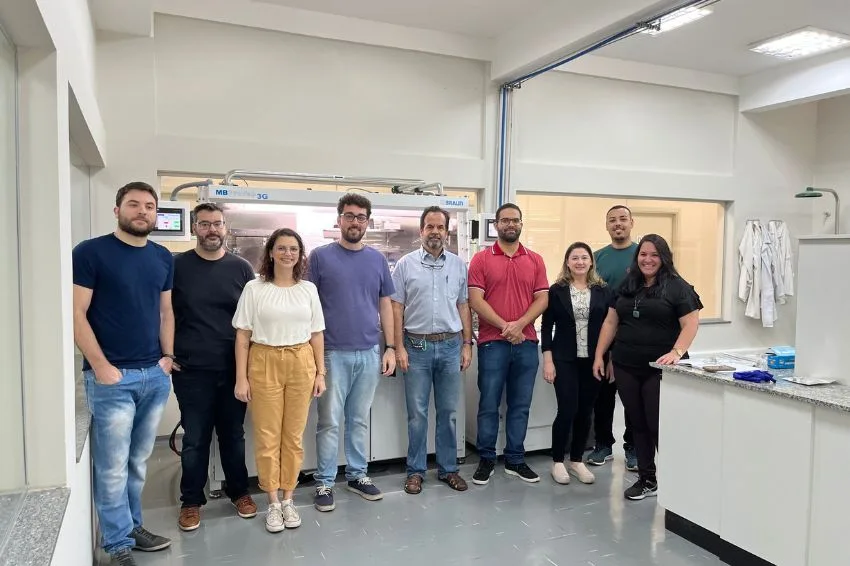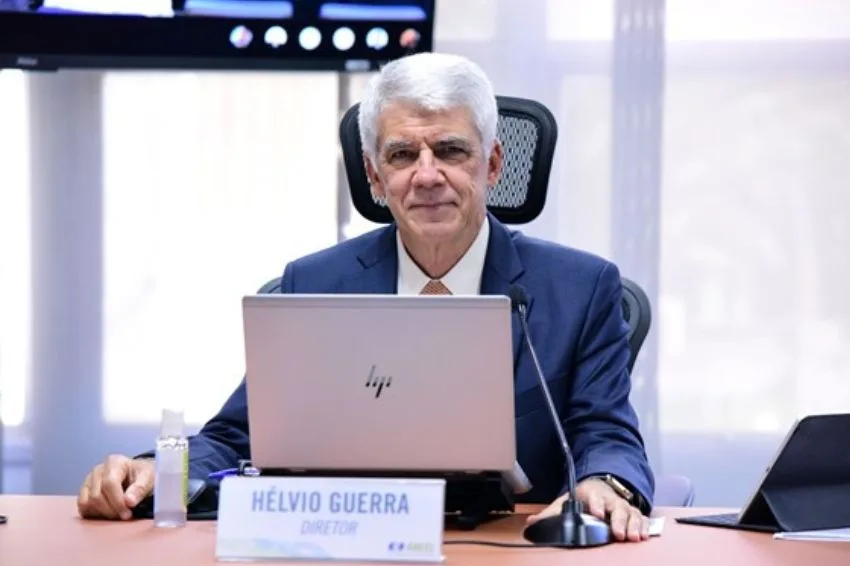Canal Solar spoke with Adalberto Maluf, director of Marketing, Sustainability and New Business at BYD, an industry that operates in the clean energy and electric mobility sector.
Maluf received the Canal Solar report at BYD headquarters in Campinas-SP and showed us his vision on the solar energy scenario in Brazil. Without hiding his indignation with some recent facts in the solar sector, Maluf points out the distortions found in the RN482 review process.
An energetic advocate of sustainability and clean energy, Maluf has represented BYD, a manufacturer of solar modules, electric vehicles and batteries, at many events and forums in Brazil and abroad. BYD was elected in 2019 one of the 100 most influential companies in the energy market in Brazil.
Who is Adalberto Maluf
Adalberto Felício Maluf Filho has a bachelor's degree in International Relations and a Master's degree in International Political Economy from the Institute of International Relations of the University of São Paulo (IRI/USP).
He worked on themes and projects related to climate change mitigation and public policies, with a focus on energy, sustainability and urban mobility.
Adalberto was an Advisor at the Environment Secretariat of the city of São Paulo between 2006 and 2007 and was director of the Clinton Climate Initiative in partnership with the C40 Cities Network (Large Cities Climate Leadership Group) in São Paulo from 2007 to 2014.
How is the photovoltaic module industry in the country?
The year 2020 promises to be very good for the solar industry, but there are still uncertainties on the sector's horizon. Between 2015 and 2017, many investments were made possible in Brazil based on a tripod that the government promised to national and foreign investors: holding auctions, creating an industrial policy for those producing in Brazil, suspending taxes on raw materials ( as imported products have exemptions), and finally, a preferential financing policy for national products.
In 2016, the government opened the first auctions, but in 2017 it canceled the following ones. These cancellations caused losses to society, as we had to connect thermoelectric plants that were more expensive and polluting than solar sources in the planned reserve auctions.
According to studies commissioned by sector associations, the cancellation generated extra costs of more than R$ 3 billion reais to the system.
Regarding industrial policy, little progress has been made in recent years. Even today, national manufacturers pay taxes on inputs II, IPI, PIS, Cofins and ICMS while imported inputs are fully exempt from IPI and ICMS, and PIS/Cofins when they have REIDI.
Now, fortunately, congress approved a bill for the new IT law and PADIS (Program to support the technological development of the semiconductor industry) at the end of 2019, which signals a new window of opportunity to finally resolve these distortions. We are optimistic about reducing costs for national manufacturing in 2020.
Another theme that has always worked in the country was compliance with BNDES (National Development Bank) rules, since special financing, such as constitutional funds, normally followed the requirement of local content.
In the BNDES Progressive Nationalization Plan, aluminum and photovoltaic modules have always been and still are mandatory items.
But distortions in financing conditions still allow financing some types of projects, even without the use of national photovoltaic modules, harming local manufacturers to the detriment of imported ones. We need to discuss these cases and create a unification of rules among public banks.
In 2019, we had a new distortion in the sector. In May 2019, the Ministry of Economy, despite negative opinions from the technical areas of the MDIC, approved an ex-tariff for a type of photovoltaic module (bifacial) even with local production of a similar good, which was prohibited by the ordinance in force at the time.
This again broke the credibility of the ANEEL (National Electric Energy Agency) auctions, which at the time had 12% of taxes on the imported module with rules of the game.
Another distortion that the ministry itself has already realized the mistake, but has not yet revoked the ordinance. This measure generated a tax exemption of more than R$ 75 million (estimated value for the exemption of 450 MWp requested by an auction winner).
And with that, part of the third pillar of respect for local content laws was broken, where only those who produce locally would have access to preferential financing.
Personally, I am in favor of using constitutional funds to finance solar projects, but only for individuals, small and medium-sized companies, as they do lead to regional development, but using these resources to finance large international players seems like a distortion to me.
Today we live in a contradiction, on the one hand, Brazil needs and requests foreign investment to generate wealth and jobs, but after companies invest, this or that public manager does not comply with the government's own guidelines.
This context creates legal uncertainty and scares investors away from continuing to invest in the country. We are in favor of reducing barriers and promoting a more liberal economy connected to the world, reducing distortions, inefficiencies and subsidies, but the Brazilian industrial sector still suffers from great injustices by paying more taxes than imports. We have to reverse this subsidy as soon as possible.
Even why, the industry is still one of the biggest INSS collectors. And if the industry ends, who will pay for the INSS deficit?
Who will generate these quality jobs here in Brazil? All developed countries, such as the United States, Germany, France, the United Kingdom and China, all have a strong industrial policy. There is no way for Brazil to grow based solely on an agro-export model.
We cannot place the burden of carrying Brazil alone on the shoulders of agribusiness. We have to create a new development model with a strong, thriving industry that feeds the services sector, industrializes our mineral and agricultural wealth, and creates jobs.
Brazil could be a great power, with a strong industrial park, generating quality jobs and consolidating itself as a regional leader in South America.
What do the industry's growth and job creation projections look like in this uncertain scenario?
Even with all these challenges, some photovoltaic module factories, like ours (BYD), did not give up on the country and invested again to change their production to supply the DG (distributed generation) market, as well as opening other areas of activity like ours new lithium battery factory and entry into the market for trains, buses and other electric vehicles (VLT).
In 2019, we operated most of the year with an extended shift at the solar factory, but with the sector's growth prospects, we decided to return to having a second shift operating at the beginning of 2020 to gain scale.
With the start of this second round, we believe that we will be able to further reduce our costs to make local factories even more competitive.
In 2017, local factories accounted for almost 50% of the market, but in 2019, we dropped to around 20% of the total market. We believe we can reverse this trend in 2020. Our goal in 2020 is to reach 30 to 35% of the market.
Currently our biggest concern is the possibility of changing the rules for distributed generation, REN 482, which would be a death knell for factories operating in Brazil.
Remember that ANEEL itself had already canceled the auctions for centralized generation of photovoltaic solar energy, forcing factories to migrate their production to modules for DG.
And now, it is signaling the end of the DG market to preserve inefficiencies in the sector and should kill the few remaining factories that have more than 80% of the DG market following BNDES rules (PRONAF, FINAME and constitutional funds).
To give you an idea, for every 1000 MW that we stop producing here to buy imported goods, the government loses around R$ 200 million in taxes, worsens the trade balance and gives up 15 thousand direct jobs. Not to mention the other social, economic and environmental benefits.
Is it good for those who change the 482?
The biggest beneficiary of this change to 482 are the forces of inefficiency, the lobby of some delayed electricity distributors, who want monopolies and methodologies that protect them and pass on losses and extra system costs to all consumers.
Does it make sense for Brazil to have the second most expensive energy tariff in the world with our clean and abundant water sources? Of course not. It only makes sense because ANEEL is more concerned with defending the investments of generators and distributors than with protecting the consumer.
There's a lot to be changed. I even agree that it is not ANEEL's role to think about a more integrated public policy on the topic, but the rules of the electricity sector should not be based solely on preserving the investments made, even if inefficient, by electricity distributors.
When ANEEL decides to present an account of “possible hidden subsidies from GD”, but at the same time forgets the benefits of GD of turning off thermal plants, saving water in hydroelectric reservoirs, postponing investments in transmission and distribution in the same account, it chooses a side clearly.
I'm also against cross-subsidies, but why do they want to confuse public opinion about these cross-subsidies instead of technically debating the benefits and harms of distributed energy generation? I hope that the MP, TCU and Congress study this very carefully.
Is it a good time to discuss changes to RN 482?
In my opinion, no. By proposing a drastic change to normative resolution 482, which proposes to tax distributed generation by more than 62%, ANEEL runs the risk of removing the possibility of millions of people having access to quality electrical energy. Today we have millions of people who do not have access to a reliable network.
With the economy growing in the short term, there may be a lack of energy in Brazil in 2021 and 2022, and DG could meet this demand, but ANEEL seems to turn a blind eye to this. In Brazil today, agribusiness is unable to expand due to a lack of quality energy.
GD allows agriculture, indigenous and quilombola communities, and small and medium-sized entrepreneurs to have access to quality clean energy at a lower cost.
I was in Pará recently inaugurating a solar system financed by international NGOs. The Village Chief said that that new solar system would change everything. Children in the village were forced to eat canned food because it was not possible to refrigerate the food.
Access to energy also means improving food, education and quality of life for those who need it most, this cannot be neglected.
The proposal to change resolution 482 talks about potential future costs with consumers leaving the grid, but does not measure the benefits of DG for the grid itself and the electrical system. ANEEL needs to discuss GD in a fair way and highlight the real benefits as well.
ANEEL should focus on the more than R$ 20 billion of cross subsidies in the CDE (Energy Development Account) where GD represents nothing. I want to see ANEEL go into the large sectors of the economy that are subsidized, instead of the small ones that generate their own energy.
The agency has not criticized the high subsidies for coal, diesel thermal plants, specific sectors such as low income, irrigation and large consumers. But now that the MP, TCU and congress have entered the fray, they will have to discuss the benefits of GD.
What benefits does GD bring?
There are many electrical and energy benefits of DG. If I generate my own energy, the surplus will be consumed by my neighbor directly, without distribution losses, and saving water in the hydroelectric reservoirs.
It consumes my energy and pays the distributor full tariff. For the distributor, it is much better, as it avoids bringing energy from far away (17% of losses) or the eventual purchase of energy from thermal plants (which covers consumption at peaks).
A study by the University of California showed that in Brazil, in November 2019 alone, distributed generation had avoided the purchase of R$ 66 million in more expensive energy by distributors, which would be shared at everyone's cost.
This would be almost R$ 800 million savings per year in the marginal cost of energy alone, 10 times more than ANEEL claims to have from subsidies on the network with GD.
During consumption peaks in the afternoon, GD supplies the distributor's consumers without the need to purchase more expensive energy from thermal plants. There is great simultaneity in solar DG with current consumption, but ANEEL distorts this data.
With DG generating during the day (and postponing consumption until night), we have the consequence of lowering the cost of operating the national electrical system. Furthermore, GD postpones investments in transmission and distribution and this has an impact on reducing the cost of energy for the entire population.
The public sector itself has an important tool in distributed generation to stabilize its energy costs, opening doors to be more efficient, but the distributors do not want this to happen.
See the case of California, when the Distributors Research Institute argued that GD would not bring benefits to their system, and that GD would be the poor subsidizing the rich. And these same fallacious arguments are now used in Brazil.
The University of Berkeley studied the topic, concluding that only by postponing 20 new transmission investment projects, and reviewing another 21 projects, DG would have reduced peak consumption in California by 3 GW, generating annual savings of US $ 2.6 billion to consumers. So the distributor lost the argument, and the Californian consumer won.
Why doesn't ANEEL carry out a study like this in Brazil? Why do they only mention the potential costs of consumers leaving the captive market and nothing is said about the benefits? The ministry wants to reduce subsidies and impose a liberal policy, and I agree with that.
Some quickly bought into the distributors' distorted arguments without consulting anyone, and this is very harmful to the country. However, many voices within the ministry have now realized how wrong that technical note was, and they are now advocating a broader debate with society.
Why did ANEEL launch a disinformation campaign on social media accusing GD of subsidy on the same day it opened consultations for a public hearing on the topic? They have already chosen their side, and part of the ministry has bought into these false arguments.
Are you referring to the Ministry of Economy that harshly criticized the current model for offsetting energy credits?
Yes. In this technical note from the Ministry of Economy (“SECAP's vision of the energy sector: The case of Distributed micro and minigeneration”) it is clear that the advisors' intention in writing the report was to meet the demands of Minister Guedes, who preaches the reduction of subsidies and distortions.
I also agree with the minister, but I buy the distorted arguments brought by the distributors, and reproduced as if they came from a technical study carried out by the ministry itself.
I also agree with the removal of cross subsidies, but they only mentioned the “future” subsidies for distributed generation, in their mistaken view of around 100 million reais, but they forgot about the more than 20 billion subsidies to other sectors such as coal and diesel, specific sectors and the distributors themselves. It's because?
I think they bought the distributors' arguments without discussing them with all the sectors involved. See, for example, their argument that a solar system would generate energy at a cost of R$118.57/MWh (here they use data from a large centralized plant) while distributed generators would have a remuneration of R$ 750 MWh, which would be to the average cost of energy in the country.
Therefore, in their thesis, there would be this implicit “subsidy” because I would be generating R$ 118.57, not paying taxes and charges, and receiving R$ 750/MWh. But that is an incredible distortion.
They want to deceive public opinion by comparing the cost of centralized generation (R$ 118.57/MWh in the 2019 A-4 auction) as if it were the cost for distributed generation (which is closer to R$ 400 to 500/MWh), however , in the current compensation system, the distributed generator only keeps credits, therefore it does not sell energy at the grid price to anyone, as argued in the technical note (R$ 750/MWh as average price for B1 consumer in Brazil).
It's a distortion in the numbers that I can't understand. If government technicians knew the sector, they would know that the distributors' numbers were wrong. In practice, whoever generates a surplus is helping the grid by bringing new, cheaper energy to my neighbor.
So why did the Ministry of Economy use such distorted data? If everyone in the sector knows that that number is not representative, why did the secretary (SECAP) use this data?
In their technical note they argue that solar energy does not create jobs, but IRENA (international energy agency) says that photovoltaic solar energy is the energy source that generates the most jobs per energy source, currently leading the world. Who is right?

It is often said that in this study large groups of investors are treated in the same way as a person who wants to install a system in a small business to reduce costs, for example. How do you see this issue of comparing large groups of investors with small ones?
It makes no sense to compare large economic groups that invest in generation to sell energy, with consumers who generate for their own consumption. We live in the era of Fake News, but it is sad to see ministries or a public agency using distorted data.
Last week, for example, the president of ANEEL argued that we would have around R$ 3 billion in subsidies on generation from incentivized sources, and said that this was from solar energy.
It is not correct, the vast majority of subsidies are made to large consumers in the free market (large companies) and in encouraged centralized generation, where wind energy represents the vast majority.
The SECAP (ME) study itself mentions that it is not fair for a DG producer to sell energy and benefit from these incentives, but the current resolution 482 itself does not allow the sale, it only provides compensation. So why do they use this data?
For me, they try to distract or misinform public opinion by stating things that don't happen in practice. They crunch numbers to distort the reality of the facts. They seem to be paying close attention to the numbers presented by large groups to the detriment of everyone's diffuse rights.
For me it is nonsense. The whole world has been encouraging distributed generation, giving freedom and empowerment to consumers, because it is good for the economy and society as a whole. We, unfortunately, can move towards what happened in Spain, which is a case of failure of distributed generation in the world.
They created important GD compensation legislation. The market grew, then a government came in and decided to abruptly end the program without respecting the rules.
The market collapsed. Naturally, several legal actions were filed, and to this day the state of Spain pays the bill for this mistaken measure, and not only for not having fulfilled the acquired right, but for not having preserved the legal security of the sector, scaring away new investments, generating unemployment. and losses. We don't want this to happen in Brazil either.
Brazil should follow the example of Germany, the United Kingdom, Japan, the United States, Australia, China, France, and many other countries in the developed world that invest heavily in DG, whether solar, biomass or PCH.
It is up to ANEEL to decide, but with Brazil's credibility in mind, which could be damaged, as we have seen in previous governments that made mistakes that cost society billions.
In October 2019, at the height of the congressional debate on GD, a Senate legislative consultant wrote a legislative bulletin (n° 82) to argue that the SECAP study and data from ABRADEE (Brazilian Association of Electric Energy Distributors) were correct, and repeating the same distortions, concluded that the revision of REN 482 was “adherent to modern concepts of sustainability” and “social justice”.
Was ending everyone's right to generate their energy to preserve inefficiencies and monopolies justified to promote sustainability and social justice? So why did this same consultant remove from his online CV on Linkedin that he was a consultant for large distributors? Would this information make your arguments lose “credibility”?
In your opinion, is there a need for a more conclusive study?
Certainly the government as a whole and ANEEL should indeed discuss all the subsidies that exist in the sector. I think the numbers should be open and it should be shown who receives subsidies in the CDE, when and how we can reduce everyone.
We will see that coal receives more subsidies than DG, which uses renewable sources, that diesel receives much more subsidies, that system losses due to inefficiency generate more subsidies, while DG reduces investments in these dirty energy sources, in losses, and that the final balance, according to many international studies, is favorable to GD. But why don't they want to argue? It is up to ANEEL to respond.
Let's open the numbers, show the energy costs for the system and also the electrical, social and development benefits that DG brings. When we have a systemic study that shows both sides, the sector will be willing to discuss how much to pay for the use of the thread that is actually being used.
There is a lot of talk that ANEEL has not considered social benefits such as, for example, job creation. What is the justification?
They have already argued that it is not ANEEL's role to predict these benefits, which is a demonstration of how they accept that they are being partial, favorable to one side only.
ANEEL thought it was correct to try to calculate fictitious future costs for the network by having captive users leaving the distributors' monopolies, but forgot the electrical and energy benefits of this same process.
If you don't want to talk about the electrical and energy benefits that are easy to calculate, just imagine talking about the social, economic and development benefits. I even understand that they don't want to get into all the tax issues, about job creation, income generation, indirect taxes.
These are broader public policy issues. But the electrical and energy benefits of DG for the national electrical system cannot be ignored. This is a distortion and a breach of the public interest.
What about the environmental benefits of DG?
There are studies that show that an increase of 5% of DG in the electrical matrix would generate a reduction of R$ 138 billion in public health costs, simply because you turn off diesel generators and thermoelectric plants.
Other data are the reduction of 232 million hectares in land use in Brazil, which would be used for large hydroelectric plants designed for the future, not to mention the environmental challenges of these hydroelectric plants (the majority would be in the Amazon region).
Living in Fortaleza, for example, can make you lose 4 years of life expectancy if you are close to a thermoelectric plant. The Northeast has all its reservoirs low, there is no way to generate energy with hydroelectric plants, and GD can fulfill this complementary role. Solar, wind and hydroelectric DG are the perfect combination of renewables. They guarantee 24 hours of steady generation.
The highest consumption in the Northeast is during peak hours from 12pm to 6pm, which is exactly when GD is generating. And even when the rains return to the Northeast, if they will return with the increase in the planet's temperature, the hydroelectric plant that supplies Fortaleza loses almost 17% of the energy generated when traveling the 700 km of transmission line between generation and consumption.
With this in mind, the government of Ceará opened a PPP (public-private partnership) to contract 45 MW in solar DG to supply its water pumping and sanitation system.
So, when changing the GD rule there is not only an impact on the private sector, the public sector is also harmed, which is the case of Ceará, which made this tender to stabilize the cost of electricity, being able to generate clean energy, replacing the energy generated by thermoelectric plants.
You were part of President Jair Bolsonaro's delegation visiting China last month, even speaking directly with him about the subject. What is your perception regarding the president’s position regarding 482?
In my conversation with President Bolsonaro, when I mentioned some of the distortions that are being presented in this review of REN 482, the president was supportive and said that he didn't agree with that, that it really doesn't make sense to want to tax the sun like that.
He said he was against this measure, and that he did not understand why ANEEL did this. Afterwards, in press interviews, he confirmed that he thought it was wrong for ANEEL to have more power than the ministers themselves, and that we need to create an integrated public policy for the sector, and not depend solely on ANEEL's vision on the topic.
Important reforms are taking place, the economy is showing signs of growth, energy consumption is expected to increase in the coming years. Is it strategic for the country to discourage people and private companies from investing in energy generation systems?
Certainly not. Brazil will grow in 2020, 2021 and 2022, and we have a serious risk of running out of energy in the coming years, and GD can help the country to have energy, to continue to grow without the need for large investments in transmission and distribution, which increase the fare for everyone in sequence.
If DG grows, everyone's tariff would not increase in the future, but if the economy grows and we have to continue to use more thermal plants, carry out expensive transmission and distribution projects, this bill would be shared among all citizens.
Today the distributed generation sector has already invested R$ 7 billion and has created more than 100 thousand jobs. It is a sector that will grow a lot and is expected to generate 670 thousand jobs by 2030.
This investment and income generation are very democratic, as they are worth so much to the person at home, to small businesses, to service providers and industries.
On the other hand, we have several actors in society who benefit from guaranteeing the monopoly and investment of large groups, going against this natural growth of solar DG, biomass or PCHs.
Ultimately, the proposed amendment to resolution 482 will harm all energy consumers in favor of preserving a monopoly of inefficiency. We live in a great dilemma today.
Do we want to be the paradise of large international investors guaranteeing inefficiencies and monopolies? Or do we want to give everyone the freedom to generate their own energy, and have this future savings to invest in education, health or leisure? Should the government decide soon? Brazil above all, or the forces of inefficiency above all?


















